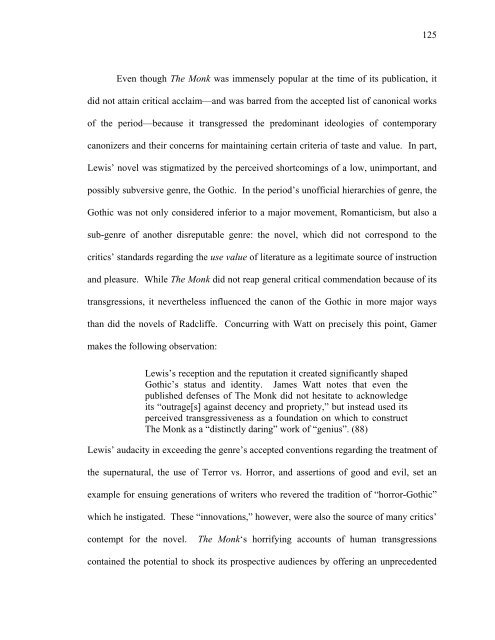Untitled - Sexey's School Moodle
Untitled - Sexey's School Moodle
Untitled - Sexey's School Moodle
Create successful ePaper yourself
Turn your PDF publications into a flip-book with our unique Google optimized e-Paper software.
125<br />
Even though The Monk was immensely popular at the time of its publication, it<br />
did not attain critical acclaim—and was barred from the accepted list of canonical works<br />
of the period—because it transgressed the predominant ideologies of contemporary<br />
canonizers and their concerns for maintaining certain criteria of taste and value. In part,<br />
Lewis’ novel was stigmatized by the perceived shortcomings of a low, unimportant, and<br />
possibly subversive genre, the Gothic. In the period’s unofficial hierarchies of genre, the<br />
Gothic was not only considered inferior to a major movement, Romanticism, but also a<br />
sub-genre of another disreputable genre: the novel, which did not correspond to the<br />
critics’ standards regarding the use value of literature as a legitimate source of instruction<br />
and pleasure. While The Monk did not reap general critical commendation because of its<br />
transgressions, it nevertheless influenced the canon of the Gothic in more major ways<br />
than did the novels of Radcliffe. Concurring with Watt on precisely this point, Gamer<br />
makes the following observation:<br />
Lewis’s reception and the reputation it created significantly shaped<br />
Gothic’s status and identity. James Watt notes that even the<br />
published defenses of The Monk did not hesitate to acknowledge<br />
its “outrage[s] against decency and propriety,” but instead used its<br />
perceived transgressiveness as a foundation on which to construct<br />
The Monk as a “distinctly daring” work of “genius”. (88)<br />
Lewis’ audacity in exceeding the genre’s accepted conventions regarding the treatment of<br />
the supernatural, the use of Terror vs. Horror, and assertions of good and evil, set an<br />
example for ensuing generations of writers who revered the tradition of “horror-Gothic”<br />
which he instigated. These “innovations,” however, were also the source of many critics’<br />
contempt for the novel. The Monk‘s horrifying accounts of human transgressions<br />
contained the potential to shock its prospective audiences by offering an unprecedented



